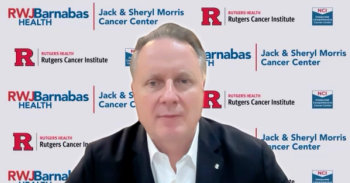
Beat AML Master Trial Finds Strong Response With Triplet Therapy: Ashley Yocum, PhD
The Beat AML Master Trial found high remission rates and promising safety with triplet therapy in patients with acute myeloid leukemia (AML), according to Ashley Yocum, PhD.
In part 2 of an interview conducted at the
She concludes by outlining future research directions for the Beat AML Master Trial and shares her perspective on how it could shape the standard of care and influence clinical guidelines for
Watch
This transcript was lightly edited; captions were auto-generated.
Transcript
What new insights from the Beat AML Master Trial were highlighted in your abstract presented at the EHA 2025 Congress?
At this presentation, he [Joshua Zeidner, MD] revealed the results of our revumenib, venetoclax, and azacitidine study. In this phase 1, the dose escalation and dose expansion study, the primary goal of the study was just to look for the recommended dose to move forward. What we have found is that when you combine the menin inhibitor revumenib, then it increases the response rates for [patients with] NPM1 mutations, as well as [for patients with] KMT2A rearrangements.
What we see is pretty significant. VEN+AZA [venetoclax plus azacitidine] had a response rate of 67% with CR [complete remission], CRi [complete remission with incomplete recovery]. But when we look at our patients [in] this study, we had an overall CR, CRi, CRh [complete remission with partial hematological recovery] of 88%.
When you break this down into the different groups, the patients who had NPM1 [mutations], they had 85% response rate, where the [patients with] KMT2A [rearrangements] had 100% response rate with this triplet therapy. [What] was also important to note is that all of these responses were 100% MRD [minimal residual disease] negative by flow cytometry. This is really important because we've seen, overall, in the AML field that patients who have MRD negativity have a longer and more durable CR rate. This is looking to be a rather good treatment for patients with these mutations.
When you look at KMT2A in particular, those patients with VEN+AZA alone, they had a median overall survival of 2.5 months. With our study, again, as I said, this is a medium overall survival of 15.5 months with all of our patients, and this has been pretty significant.
Another good thing that has come out of the study is that we've had 10 patients, or 23% of the population, go on to receive transplants, and this is very good for [patients with] AML. This treatment is also very safe. There have been [a] limited QTc [corrected QT interval] prolongation, as well as limited differentiation syndrome, none of which resulted in grade 4 or grade 5, and all of them resolved without having treatment discontinuation. They all were manageable, so this is a safe treatment.
Through the dose escalation portion of the study, dose level 1 had one heme-related DLT [dose-limiting toxicity], and then we escalated up in the traditional 3+3 method. We saw no DLTs in the second dose.
With the phase 3 study now in development, what key questions are you aiming to address next?
The phase 3 study, the EVOLVE-2 study, sponsored by HOVON, is going to answer how long these patients [will] stay alive with this treatment. With the preliminary results from the phase 1 study, we're very optimistic that these patients are going to live longer and have a more durable response than [with] VEN+AZA alone.
The HOVON group also [has] a lot of different correlatives going on, and they're also going to be monitoring MRD through flow cytometry and sequencing. We're hoping to see how this treatment influences MRD, as well as the responses in the overall survival for these patients.
How do you envision the long-term impact of the Beat AML Master Trial on the standard of care and clinical guidelines for AML?
[The] Beat AML [Master Trial], so far, on [the] standard of care, we did have our initial results saying that it's okay to wait for treatment. You do not have to treat the same day, so that was practice-changing.
The next thing that we hope is really going to be practice-changing is publishing the results of our OptiAML study led by Uma Borate, MBBS. We anticipate [having] these results at the end of December, and we really believe that this will move the triplet field forward.
As of right now, it's very hard to be able to combine novel agents with VEN+AZA without having to dose modify too much. Along with the toxicities, it's hard to really evaluate how these newer agents can be added to that backbone. Also, for other sub-studies that we're bringing on, we really hope that with our precision medicine approach, by matching patients based on their genomics to specific treatments, it's really going to help individualize AML therapy to each patient.
Also, what Beat AML is doing right now, as we expanded our original program to not just do newly diagnosed AML but also relapsed [or] refractory [AML]. We're currently trying to look [into] how Beat AML can influence relapsed [or] refractory treatment and hopefully change that standard of care for those patients in the future.
Newsletter
Stay ahead of policy, cost, and value—subscribe to AJMC for expert insights at the intersection of clinical care and health economics.













































